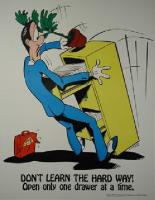If you know a young person who is considering doing volunteer work, or beginning a new job, here’s some common-sense advice to give them. These suggestions are excellent for all workers, regardless of age. Whether it is volunteering in a facility such as a hospital, nursing home, or humane shelter, or starting a new job, there are rules and regulations to be followed.
Here are thirteen steps that we hope everyone will abide by:
1. Get training. Can you show me how to do it? What things should I watch for?
2. Learn how to do the job safely. Follow the policies, procedures and rules. Be aware of what to do in an emergency.
3. Be supervised. If my supervisor is not near to where I am working and I have a question, to whom do I go?
4. Wear the gear. If Personal Protective Equipment or PPE is required, such as gloves, aprons, hairnets, safety glasses, ear plugs, etc., find out how to use them properly and wear them.
5. Think the job through and identify risks before beginning. Understand unsafe practices or situations and report them.
6. Ask, Ask, Ask. There are no stupid questions, just stupid excuses when you do something without being told, and without instructions. Don’t be afraid to communicate. Try to ask smart questions and not give answers such as, “I didn’t know”, or “No one told me”.
7. Don’t do anything that you haven’t been instructed to do safely and don’t do anything you’ve been told not to do, for anyone! The supervisor rules. If others ask you to do something you have been told not to do, or have not received training in, check with your supervisor before you do it.
8. Follow rules. Every job and every game plan has to include rules to ensure that everyone plays fairly, moves the ball together, and acts like a team.
9. Tell your supervisor if you see anything hazardous that may hurt someone else or you. If you see them doing something that you know could injure them, report it. Who is doing it is not as important as what is being done. You’re not ratting, you are making a mature move to prevent unnecessary injuries.
10. Remember you are not being asked to give until it hurts! If you get hurt, no matter how minor it may seem to you, report it to your supervisor and let your family know.
11. Talk to your family and let them know what type of tasks you’ll be doing and the training you have received. If you have any concerns or things that feel aren’t right, tell them. Sometimes your parents know things you don’t.
12. Be honest. If you think the task is beyond your personal capabilities, let the employer know right away. Don’t take on anything that you can’t handle.
13. Don’t assume you can do something you haven’t done before without some instructions or supervision, and never do anything more than what you were actually told to do without checking with the supervisor first.
This is good advice for all of us. Remember, your health and safety is more important than any job or paycheck. Pay Attention! Keep your eyes open and don’t be afraid to speak up. You need to protect yourself.
Source: Ministry of Labour, Canada
